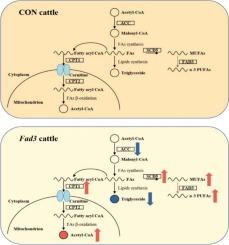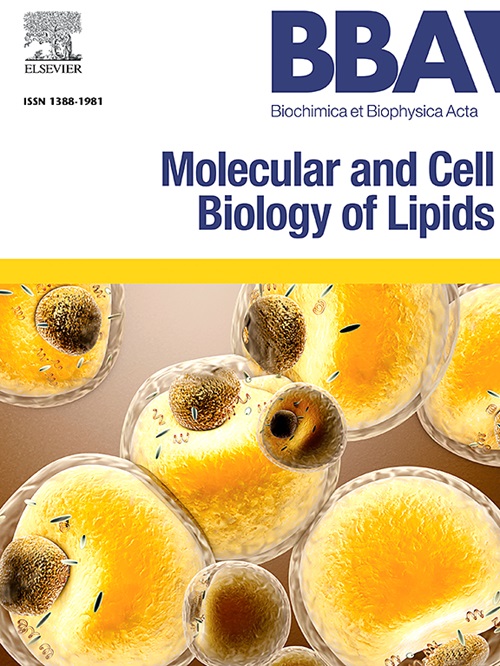内源性合成n - 3 PUFAs可以减少Fad3转基因牛的脂质合成
IF 3.3
2区 生物学
Q2 BIOCHEMISTRY & MOLECULAR BIOLOGY
Biochimica et biophysica acta. Molecular and cell biology of lipids
Pub Date : 2025-07-28
DOI:10.1016/j.bbalip.2025.159672
引用次数: 0
摘要
n - 3多不饱和脂肪酸(PUFAs)在哺乳动物的健康、发育和生长中起着重要作用。然而,大多数哺乳动物,包括人类,不能合成n - 6和n - 3 PUFAs,只能从饮食中获得。来自亚麻的脂肪酸去饱和酶3 (Fad3)基因编码一种脂肪酸去饱和酶,通过∆15的去饱和将n - 6 PUFAs转化为n - 3 PUFAs。利用转基因技术生产Fad3转基因牛可能是人类获取n−3 PUFAs的有效途径。本研究以fad3转基因和野生型(对照,CON)鲁西黄牛成纤维细胞为模型系统。我们系统地比较了两组细胞在内源性基因表达、代谢物丰度、脂肪酸去饱和能力和脂质合成代谢/分解代谢途径方面的差异,旨在阐明通过FAD3合成的内源性n - 3 PUFAs如何调节脂质代谢。在Fad3转基因牛中,硬脂酰辅酶a去饱和酶5 (Scd5)基因表达上调,促进脂肪酸去饱和。内源性PUFAs下调脂质合成相关基因表达和乙酰辅酶a羧化酶(ACC)活性,上调肉碱棕榈酰基转移酶1 (CPT1)酶表达,减少脂质合成,增加脂肪酸β-氧化,从而减少脂肪沉积。综上所述,Fad3转基因牛有望提高牛肉的营养价值,并可作为家畜动物模型来研究n−3 PUFAs的有益作用。本文章由计算机程序翻译,如有差异,请以英文原文为准。

Endogenous synthesis of n−3 PUFAs can reduce lipid synthesis in Fad3 transgenic cattle
n−3 polyunsaturated fatty acids (PUFAs) play important roles in the health, development and growth of mammals. However, most mammals, including humans, cannot synthesize n−6 and n−3 PUFAs and can only obtain them from the diet. The fatty acid desaturase 3 (Fad3) gene from flax encodes a fatty acid desaturase that convert n−6 PUFAs to n−3 PUFAs through desaturation at ∆15. The use of transgenic technology to produce Fad3 transgenic cattle may be an effective way for humans to obtain n−3 PUFAs. This study utilized fibroblasts derived from FAD3-transgenic and wild-type (control, CON) Luxi Yellow cattle as a model system. We systematically compared differences between the two cell groups regarding endogenous gene expression, metabolite abundance, fatty acid desaturation capacity, and lipid anabolism/catabolism pathways, aiming to elucidate how endogenous n−3 PUFAs synthesized via FAD3 regulate lipid metabolism. In Fad3 transgenic cattle, the expression of stearoyl-CoA desaturase 5 (Scd5) gene was up-regulated which promote fatty acid desaturation. Endogenously PUFAs down-regulate the expression of lipid synthesis-related genes and the activity of acetyl-CoA carboxylase (ACC), up-regulate the expression of carnitine palmitoyltransferase 1 (CPT1) enzyme, reduce lipid synthesis, increase the β-oxidation of fatty acids, and thus reduce fat deposition. In summary, the Fad3 transgenic cattle are expected to improve the nutritional value of beef, and can be used as a livestock animal model to study the beneficial effects of n−3 PUFAs.
求助全文
通过发布文献求助,成功后即可免费获取论文全文。
去求助
来源期刊
CiteScore
11.00
自引率
2.10%
发文量
109
审稿时长
53 days
期刊介绍:
BBA Molecular and Cell Biology of Lipids publishes papers on original research dealing with novel aspects of molecular genetics related to the lipidome, the biosynthesis of lipids, the role of lipids in cells and whole organisms, the regulation of lipid metabolism and function, and lipidomics in all organisms. Manuscripts should significantly advance the understanding of the molecular mechanisms underlying biological processes in which lipids are involved. Papers detailing novel methodology must report significant biochemical, molecular, or functional insight in the area of lipids.

 求助内容:
求助内容: 应助结果提醒方式:
应助结果提醒方式:


